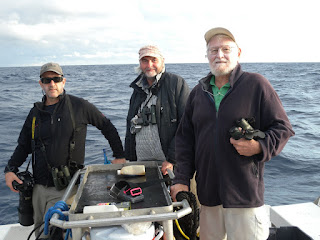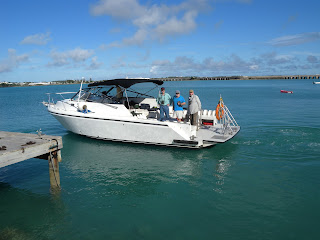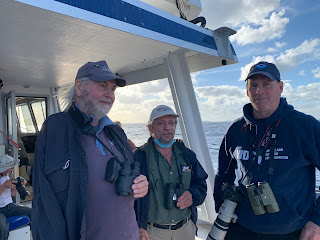As we move into 2022 we all can use some good news, especially on the conservation front and even more so on a seabird front! The Bermuda Petrel (Pterodroma cahow), or Cahow as it is locally known, checks all of these boxes for us. For those of you unfamiliar with this species, though if you're reading this blog you must have seen them mentioned before, the Cahow is what is called a Lazarus species. A species that was once thought extinct, in this example for over 400 years, that is rediscovered. In the case of the Cahow, it was just hanging on to existence when rediscovered in 1951 with seven burrows occupied. Now seabirds are generally speaking long lived species, so it would not be impossible for them to go unnoticed for long periods of time especially when nesting in places humans do not frequent. Dr. David Wingate was integral to the survival of this species, monitoring all nesting activity, creating new, artificial burrows to increase the population, removing rats from nesting islets, discovering that the White-tailed Tropicbird posed a threat to chicks and thwarting their entrance to burrows, taking the fight over DDT to the courts in the US, and taking Nonsuch Island in Castle Harbor back to its natural state. In general, rescuing this species from the brink. In 2000 current Chief Conservation Officer Jeremy Madeiros took over from David, having been his protege for many years, and began his own chapter in the story of the Cahow. He carried on with David's work and added another layer - interacting with the birds by banding them, weighing and measuring them, and initiating a translocation program that took chicks from the smaller, low lying islets and moving them into a colony on Nonsuch Island which until this point had no nesting Cahows. This program began in 2004 and presently there are two translocation colonies on Nonsuch Island which now hosts the second largest colony in Bermuda with over 30 nesting pairs!
In 2011 Dr. Robert Flood (Bob), organizer of the Cahow Experience, planned a trip to Bermuda to research the Cahow for his upcoming Pterodroma Petrel guide. Keen seabirder Hadoram Shirihai joined him on this expedition as well. That year they chartered a small dive boat to go to sea six times (photo below). Bob was able to visit Nonsuch with Jeremy, yet left feeling like he needed more time at sea with these gadfly petrels. He was able to organize another research trip the following year in 2012, again chartering a small dive boat and heading to sea eight times (photo below). All but one of these trips registered only single digit Cahow sightings, and of those only a handful were even close! Maximum seen on the 2012 trip was 10. Again Bob was able to join Jeremy on Nonsuch for banding studies and see the nesting Cahows in the hand. He had a number of people express interest in joining him to search for these rare seabirds in Bermuda so in 2013 he organized a small group. That year the most seen on one trip was six Cahows. I read about these trips on a seabird news group in 2014 and planned to join in 2015. Having worked for Seabirding for almost 15 years by that time, I had seen a number of Bermuda Petrels, or Cahows, offshore from Hatteras, NC but the chance to see them where they nest was irresistible. Not only did we see a number of Cahows at sea that year but we also had the first photographed Trindade Petrel for Bermuda on one of the trips! Seeing these birds in the hand and learning about them first hand from David and Jeremy was life changing. And to smell a Cahow? Well, I was hooked! Bob invited me to help him lead the tour in 2016 and the rest is history. We had groups join us in 2017 and 2018 then we were unable to make it a go in 2019, and November 2020? Well, you might suspect why that didn't run!! So we were super excited to get back there this past November for another look at the Cahows and offer people the best opportunities in the world to photograph them and learn their story from the men who created it.
Our first inkling that this year would be different than all before came on Tuesday November 9, 2021 when, standing at Cooper's Point, we tallied FIFTY-ONE Cahows in view at once! Yes, a jaw dropping number from our high count of 20 offshore in 2018. Our first trip offshore aboard the R/V Endurance (photos below), the Bermuda Museum Aquarium and Zoo's vessel, found between 30 and 50 individuals! During the 2020-2021 nesting season there were a total of 26 nesting pairs on Nonsuch, when we visited the island on November 12, 2021 Jeremy informed us that the 2021-2022 season has over 40 as I mentioned earlier! As the population of this endangered petrel grows so does our knowledge about their natural behaviors. When I first began visiting Bermuda six years ago the general idea was that the birds we saw offshore were younger, non-breeding individuals and that adults returned directly to their burrows. I photographed some individuals that had dirt on their abdomens in 2018, this, Jeremy told me, was a result of burrowing or coming and going from a burrow. So were these young birds just prospecting? As it turns out, adults and younger birds make up the individuals we see courting and flying together offshore from Castle Harbor! Jeremy now knows that these birds will be flying, calling, and courting near the translocation colony and then return to their burrows when he is on night watch. When you ponder it, it makes sense that just a few birds who have never known life with hundreds or thousands of individuals might not exhibit the natural behavior expected from a large colony.
There were a number of firsts on this trip. We had the highest counts of Cahow recorded since the 1600s and Jeremy Madeiros himself joined us for our final trip to sea (photo below)! This final trip offshore gave us the closest looks yet at these gorgeous gadflies. At least 50 Cahows were seen on November 16, some of which came right to the boat hovering close by before zipping away. It was almost as if they could smell their keeper on the boat with us. Those of you who are addicted to seabirds, more specifically tubenoses, like I am know that their sense of smell is unrivaled. I like to imagine they could smell their strange looking companion who handles them at least once a year. The creature who for some was their surrogate parent who fed them in the translocation colony. How curious for them to smell, or hear him, at sea! Regardless of the reason, the last trip was epic. An adult White-tailed Tropicbird flew right over us as well to investigate, and while I hear that they are in the area during the fall and winter months, this was the first time these trips had recorded one that was not a rehabbed youngster being released.
Our final evening in Bermuda, November 18th, Bob was able to organize a night watch for myself and Peter Flood (no relation to Bob) with Jeremy. Unfortunately the moon was just about full, but Jeremy thought perhaps if the cloud cover remained we might see a bird or two. Another behavioral assumption shattered! We had over six birds at once flying around us near the translocation colony there on Nonsuch Island just after dusk!! They were courting and calling and we could clearly see them as they flew in the light of the full moon! As we left that evening Jeremy said, "if we have a moment, humor me! I'd like to check something out!" We pulled up to Horn Rock (photo below), the islet with the largest nesting colony at over 40 pairs, and just as we neared a Cahow flew right by us! Jeremy cut the engine and we sat observing the islet. It was like a beehive of activity!! Durning the full moon! Who would have imagined?
Bob Flood and I will be heading to Bermuda again in 2022. These trips are not traditional birding tours, but we offer the chance to take four trips offshore and to visit Nonsuch Island with Jeremy Madeiros to observe the Cahows in the hand as he checks nesting pairs to begin the season. There is also the chance to go birding around Bermuda where a number of Nearctic species are possible. In November 2021 our participants logged a number of wood warblers including Blue-winged, Black-throated Blue, Black and White, Tennessee, Blackpoll, Orange Crowned Warblers and more! The endemic White-eyed Vireo can also be easily seen on land. One of the locals in Bermuda, Lynn Thorne, organizes birding tours and will take people to some of the more productive locations for a donation towards her Wildlife Rehabilitation and Sanctuary. If anyone is interested in joining us for this 2022 seabird adventure, contact Robert Flood - live2seabird@gmail.com - or myself (Kate Sutherland) - cahow1101@gmail.com
Horn Rock, the site of the largest nesting colony with 47 pairs this season (2021-2022)!!
Scanning for Cahows aboard the R/V Endurance with David Wingate



















No comments:
Post a Comment